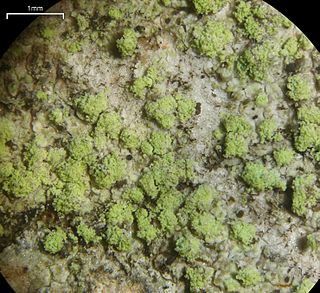
Biatora is a genus of lichens in the family Ramalinaceae. First described in 1817, the genus consists of crustose and squamulose lichens with green algal photobionts, biatorine apothecia, colorless, simple to 3-septate ascospores, and bacilliform pycnospores. According to the Dictionary of the Fungi, the genus contains 42 species that are widely distributed in temperate areas.
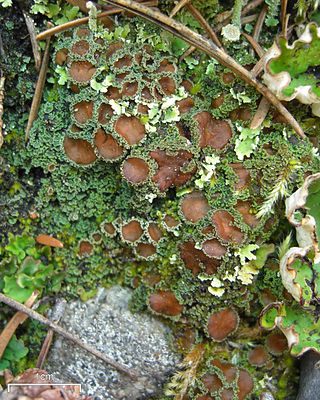
Psoroma is a genus of lichen-forming fungi in the family Pannariaceae. The widespread genus contains about 30 species, most of which are found in south temperate regions.
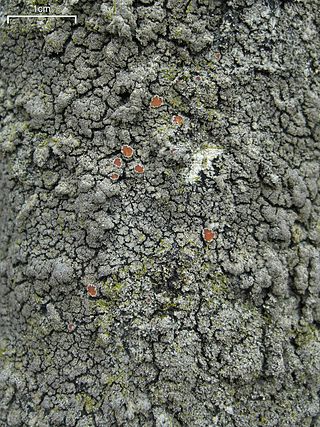
Parmeliella is a genus of lichenized fungi in the family Pannariaceae. It occurs mainly in the tropics and sub-tropics, with species found in Africa, Asia, Australasia and South America. A recent (2020) estimate places 41 species in the genus.

Pannaria is a genus of lichen-forming fungi in the family Pannariaceae. The widespread genus contains an estimated 51 species, found primarily in tropical regions.
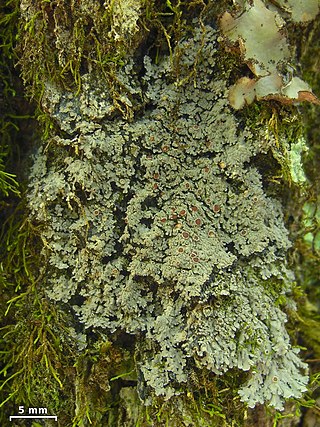
Fuscopannaria is a genus of lichen-forming fungi in the family Pannariaceae. It has 55 species.

Leptogium is a genus of lichen-forming fungi in the family Collemataceae. It has about 110 species. Species formerly classified under Leptogium have since been divided among the genera Leptogium, Pseudoleptogium, and Scytinium. Leptogium lichens are predominantly found on tree bark or soil, often among mosses, and sometimes on rocks in moist environments.
Leciophysma is a genus of cyanolichens in the family Pannariaceae. It has four species. The genus was circumscribed by Theodor Magnus Fries in 1865, with Leciophysma finmarkicum assigned as the type species.
Staurolemma is a genus of lichenized fungi in the family Pannariaceae. The genus was circumscribed by German lichenologist Gustav Wilhelm Körber in 1867, with Staurolemma dalmaticum as the type species.

Placynthium is a genus of lichen-forming fungi in the family Placynthiaceae. Members of this genus are commonly called blackthread lichens.

Degelia plumbea is a species of grey to blue-black or brown foliose lichen in the genus Degelia. It mostly grows on trees in undisturbed woodlands but occasionally on coastal rocks. It is found widely in Britain and western Ireland as well as in America and Canada, as it grows in maritime Atlantic climates.

Lepidocollema is a genus of lichens in the family Pannariaceae. It was circumscribed in 1890 to contain a single Brazilian species that has not been collected since. In 2016, the entire family was revised and updated, resulting in the expansion of Lepidocollema to 24 tropical species.
Lepidocollema wainioi is a species of lichen in the family Pannariaceae. It is known from southeast Asia.
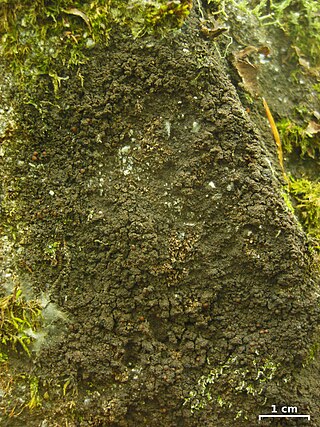
Vahliella is a genus of nine species of lichen-forming fungi in the order Peltigerales. It is the only member of Vahliellaceae, a family circumscribed in 2010 to contain this genus. Vahliella was formerly placed in the family Pannariaceae until molecular phylogenetics showed that it did not belong there. Vahliella species are found in the Northern Hemisphere – mainly in North America, but also in Europe and India.
Gibbosporina is a genus of 13 species of foliose lichens in the family Pannariaceae. It contains species that molecular phylogenetic analysis clustered together in a clade previously referred to as the "Physma"-group. Despite their morphological differences, this group shares several uniting characteristics. They have ring-like excipular margins around the thallus; strongly amyloid internal ascus structures; well-developed perispores that feature irregular gibbae, but not verrucae ; lacks secondary compounds than can be detected by thin-layer chromatography; and have tropical distributions.
Steineropsis is a genus of lichen-forming fungi in the family Pannariaceae. It has two species. The genus was circumscribed by Toby Spribille and Lucia Muggia in 2010, with Steineropsis alaskana assigned as the type species. The type specimen of this lichen was found in Skagway, Alaska, where it was growing on a rock in a snowbed at an altitude of 1,051 m (3,448 ft). The generic name alludes to a resemblance to the genus Steinera. A second species, Steineropsis laceratula, also found in Alaska, was added to the genus in 2020. Molecular phylogenetic analysis showed that Steineropsis has a sister taxon relationship to genus Protopannaria.

Lepidocollema marianum is a species of cyanolichen in the family Pannariaceae. It was first scientifically described by Elias Fries in 1825 as Parmelia mariana. Per Magnus Jørgensen transferred it to the genus Lepidocollema in 2014 following a molecular phylogenetics-guided revision of the Pannariaceae.
Nevesia is a monotypic genus of lichenized fungus in the family Pannariaceae. It contains the species Nevesia sampaiana. The genus name honors Carlos das Neves Tavares, the Portuguese lichenologist who first identified the species in 1950.

The Collematineae are an suborder of rust fungi in the order of Peltigerales in the class Lecanoromycetes.
Psorophorus is a genus of lichenized fungi in the family Pannariaceae. It contains 2 known species.











